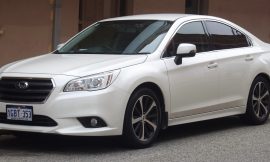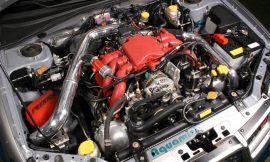Subaru EZ30 Engine
History of the EZ30 Engine
The EZ30 engine was introduced with its 220HP variant in 2000 with the Outback H6 3.0 in Europe and North America (and the corresponding Subaru Lancaster 6 wagon in Japan).
The design of the engine was lead by Noriaki Sekine [1]:
The engine had to deliver smooth power, low vibrations and be as small and light as possible. The result was an engine that was the same height as the Subaru H4 engines and was only about two centimeters longer.
The H6 engine uses dual chains to drive for the valve train and water pump and a single serpentine belt for the auxiliary systems, as opposed to the standard setup used by most Subaru engines at the time with a belt drive. This change allowed Subaru to build a 6 cylinder engine with dimensions very similar to the existing 4 cylinder engines.
In 2003 the engine received a significant overhaul, gaining over 20HP, and the new Subaru AVCS and AVLS systems. This new engine was introduced with the new generation Subaru Legacy and Subaru Outback and had 240hp @ 6600 RPM. Read more about the differences below.
The aim with the launch of the new engine in the new Subaru Legacy, was for Subaru to become a preimum brand, and as such, it needed a powerfull six cilinder engine.

It also became the standard engine in the newly launched Subaru Tribeca (in 2006).
For an overview of all the Subaru Six Cylinder Engines, visit:
Subaru EZ30 Engine Specifications
There are two different EZ30 engines, which aren’t distinguished by an internal designation. The first EZ30 engine, which we will call Mark I appeared in 1999 in the Legacy/Outback model. The second generation EZ30 engine (sometimes referred as EZ30R) appeared in the new for 2003 Subaru Legacy/Outback series. We refer to this engine as the EZ30D Mark II.
EZ30D Mark I (1999-2003)
| EZ30D Mark I | |
| Engine Code | Subaru EZ30, EZ30D Mark I |
| Production | 1999-2003 |
| Cylinder Block alloy | Aluminum |
| Deck Height | 202 mm |
| Cylinder Bore mm (inch) | 89.2 (3.51) |
| Piston Diameter | |
| Crankshaft Bore | |
| Connecting Rods | |
| Cylinder Configuration | Horizontally opposed, flat-6 |
| Valvetrain | DOHC 4 valves per cylinder |
| Displacement | 2999 cc (183 cu in) |
| Intake Manifold | Variable length aluminum |
| Power output | 164 kW (220 HP) at 6,000 rpm |
| Torque output | 289 Nm (213 lb·ft) at 4,400 rpm |
| Redline | |
| HP per liter | 73.3 |
| Fuel type | Gasoline |
| Weight, kg (lbs) | 180 (397) |
| Fuel consumption, L/100 km (mpg) | |
| Engine Type | Naturally Aspirated |
| Throttle Body | Mechanical throttle body. |
| Engine Firing Order | 1-6-3-2-5-4 |
| Oil consumption | up to 1.0 L/1000 km / (1 qt. per 600 miles) |
| Recommended engine oil | API classification SM (or SL): SAE viscosity No.: 30, 40, 10W-50, 20W-40, 20W-50 |
| Engine oil capacity, L (qt.) | 5.7 |
| Oil change interval, km (miles) | 5,000-10,000 (3,000-6,000) |
| Normal engine operating temperature, °C (F) | 90 (194) |
| Cars | Subaru Legacy/Outback |
| Euro Category | Euro III |
| Predecessor engine | None, new design. |
| Successor Engine | EZ30D Mark II |
EZ30D Mark II (EZ30R) (2003-2007)
| EZ30D Mark II (EZ30R) | |
| Engine Code | EZ30D Mark II and EZ30R (although this isn’t an official name) |
| Production | 2003-2009 |
| Cylinder Block alloy | Aluminum |
| Deck Height | 202 mm |
| Cylinder Bore mm (inch) | 89.2 (3.51) |
| Piston Diameter | |
| Crankshaft Bore | |
| Connecting Rods | |
| Cylinder Configuration | Horizontally opposed, flat-6 |
| Valvetrain | DOHC 4 valves per cylinder. AVCS and AVLS systems to modify intake valve timing and lift. |
| Displacement | 2999 cc (183 cu in) |
| Intake Manifold | Plastic, fixed runner lengths. |
| Power output | 183 kW (245 HP) at 6,600 rpm |
| Torque output | 297 Nm (219 lb·ft) at 4,200 rpm |
| Redline | |
| HP per liter | 81.7 for the EZ30D Mark II (EZ30R) |
| Fuel type | Gasoline |
| Weight, kg (lbs) | 180 (397) |
| Fuel consumption, L/100 km (mpg). | Official figures for the 2006 Subaru Tribeca: City: 13.3 (18) Highway: 9.0 (26) Combined: 10.2 (23) |
| Engine Type | Naturally Aspirated. Electronic throttle body, fly-by-wire. |
| Throttle Body | Electronic throttle body, fly-by-wire. 76 mm diameter. |
| Engine Firing Order | 1-6-3-2-5-4 |
| Oil consumption | up to 1.0l / 1000km or (1 qt. per 600 miles) |
| Recommended engine oil | API classification SM (or SL): SAE viscosity No.: 30, 40, 10W-50, 20W-40, 20W-50. [1] |
| Engine oil capacity, L (qt.) | 5.7 (6qt) |
| Oil change interval, km (miles) | 5,000-10,000 (3,000-6,000) |
| Normal engine operating temperature, °C (F) | 90 (194) |
| Cars | Subaru Legacy 2003-2009, Subaru Tribeca 2006-2007 |
| Euro Category | Euro IV |
| Predecessor engine | Evolution of EZ30 mk I |
| Successor Engine | EZ36D |
Subaru EZ30 Engine Oil Recommendations
Subaru EZ30 Fuel Recommendation
The EZ30 engine has a high compression ration (10.4:1) and as such requires premium fuel. The car’s manual says fuel with an AKI value of at least 91.
The AKI fuel classification is often used in the United States, where this is the number you see at the pump.
In Europe, the RON number is used usually. Fuels corresponding to 91 AKI in Europe are usually designed as Super 95, or higher fuels. For example, Shell’s V-Power Fuel is 100 RON and 93-94 AKI. Wikipedia has a handy table on the topic:
https://en.wikipedia.org/wiki/Octane_rating#Examples
This is one of the drawbacks of this engine that was resolved in the EZ36D evolution. The EZ36D was a lower compression engine, allowing it to run on regular gas.
The engine will run on regular. This is stated in the manual. However, due to the design of the catalytic converter system, the engine heads run hot. This combined with the lower grade fuel leads to a very pingy ride, for which the engine ECU compensates by retarding the ignition and thus, the horsepower the engine is able to produce. To be able to extract the full potential of the engine, and ensure its proper operation, premium fuel is strongly recommended.
Subaru EZ30 Fuel Consumption
While this engine is considered rather economical in the US and Australian markets, on the European continent the fuel consumption of this engine is considered very high. This is not due to the engine design itself, but rather to the power the engine is producing, the cars it is being placed on, and to the full-time 4×4 automatic transmission it is being mated to. In the years produced, there are only a few other carmakers making cars of this class. These would be the BMW E60/E61 530 Xdrive, Audi A6 (C6) 3.2FSI Quattro, Skoda Superb 3.2FSI V6 4×4, and Alfa Romeo 159 3.2 JTS Q4 all these cars have similar fuel consumption, but they are rather rare. The years Subaru produced this engine are the years in which Turbo Diesel engines really caught on, and their fuel economy is much better for heavy 4×4, cars with automatic transmissions.
Differences between the EZ30D MK I and EZ30D Mk II
In 2003 the engine was overhauled for the launch of the new premium Subaru model lineup – the Subaru Legacy 4h Gen, and Subaru Outback 3rd Gen.
Commonly referred as EZ30R, the second generation EZ30 engine never received an official new name. Some of the most notable changes Subaru did was:
- Subaru Variable intake valve timing system – AVCS with adjustment range of 50 °
- Variable intake valve lift system with adjustment three set position – 2,000 RPM, 2,000-4,000RPM and over 4,000RPM.

Image by: 160SX, CC BY-SA 3.0 (Wikimedia)
- Electronic Throttle body (fly-by-wire system) with 76mm diameter.
- Plastic intake manifold, which lost the variable runner length feature (probably due to the introduction of the AVCS and AVLS systems)
- New head design with three exhaust ports, instead of a single one. A new exhaust manifold design.
- The engine received was paired with dual exhausts, compared to a single exhaust of the first generation.
- Later variants of the EZ30 mark II received the Subaru SI (Intelligent Drive) system, which alters engine output and response dynamically, according to driver selection.
With these modifications, the engine power was increased to 245 hp at 6600 RPM (a significant improvement), but the torque improvement was rather mediocre – from 289 Nm (213 lb·ft) at 4,400 rpm to 297 Nm (219 lb·ft) at 4,200 rpm
Subaru EZ30 Engine Issues
The EZ30 series of engines is regarded as one of the most reliable engines Subaru produced in the period. During this period, many Subaru engines were suffering from leaking head gaskets, a problem which the EZ30 engine didn’t experience. Furthermore, its chain driven valve train proved very reliable and troublesome, requiring very infrequent services.
- One of the most often reported problems with the EZ30 engine, lies not with the engine itself, but with its cooling peripherals. Many users from hot climates report overheating problems, due to insufficient capacity of the cooling radiator. A common upgrade and fix of this problem is the replacement of the cooling radiator with a fully aluminium tuning model for a WRX/STI.
- The timing chain operating the valve train, although very reliable requires expensive service once the expected lifetime of the timing chain components are reached. Due to the limited space at the engine bay, this repairs is quite involved (requiring an engine removal) and expensive. Parts prices aren’t very expensive, but there are many parts. Usually, work is more expensive than the parts themselves.
- Water Pump – the water pump of this engine is replaced with the timing chain, making the timing chain overhaul more expensive. Additionally, the water pump is hard to replace if only a repair of it is required. Usually, a water pump replacement comes with the replacement of many of the timing chain components.
As with all Subaru engines of the era, high quality engine oil is a must.
Subaru EZ30 Engine Tuning
We have split the tuning article into a separate article:





